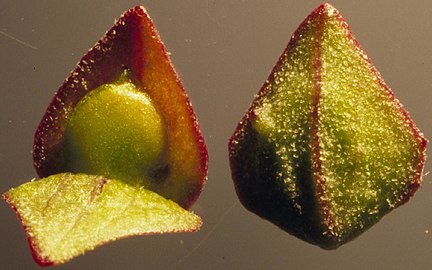Atriplex patula
| Atriplex patula | |
|---|---|

| |
| Scientific classification | |
| Kingdom: | Plantae |
| Clade: | Tracheophytes |
| Clade: | Angiosperms |
| Clade: | Eudicots |
| Order: | Caryophyllales |
| Family: | Amaranthaceae |
| Genus: | Atriplex |
| Species: | A. patula
|
| Binomial name | |
| Atriplex patula | |
Atriplex patula (spear saltbush; common orache; spear orach; spreading orach; naturalized in many temperate regions.
Description
Atriplex patula grows to be between 50 and 80 centimetres (20 and 31 inches) tall.[2] The branches extend outwards from the stem with rhomboid leaves and separated clusters of flowers.[2] The species accumulates salt from the environment in its tissues. Unlike other Atriplex species, it lacks notable salt bladders to excrete salt onto the leaves.[3]
Taxonomy
The species was a member of the family
Distribution and habitat
The species has a wide range, including semi-arid deserts and coastal areas in Asia, North America, Europe, and Africa.[2] It commonly grows along roads and waste sites.[4]
Although it is commonly asserted that the species has been naturalized in North America only since the 18th century,[5][6] seeds ascribed to this species occur on the west coast of North America in buried marsh deposits that predate European contact.[7][8]
Uses
The young leaves and shoots are edible raw or cooked and suffice as a spinach substitute.[9]
The species has been proven to be effective in lowering salt content in soils when planted in areas with high road salt contamination.[3]
References
- ^ "orache". Oxford English Dictionary third edition. Oxford University Press. June 2004. Retrieved 7 December 2018.
- ^ .
- ^ S2CID 221162683.
- S2CID 17780607.
- ^ Atriplex patula in Flora of North America
- ^ "USDA PLANTS Profile". Archived from the original on 2013-05-11. Retrieved 2008-05-20.
- ^ Sherrod BL, 2001. Geological Society of America Bulletin 113, 1299-1311.
- ^ Milker Y, et al., 2016. Quaternary Science Reviews 142, 143-163.
- ISBN 978-000-743847-1.


